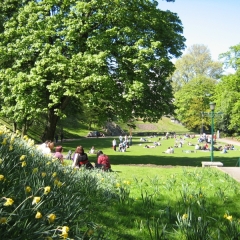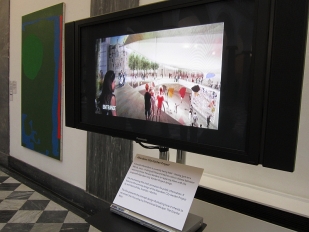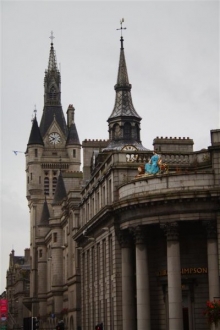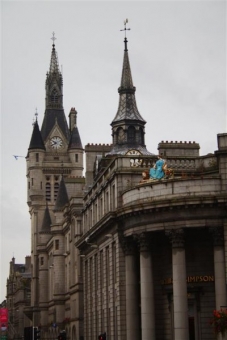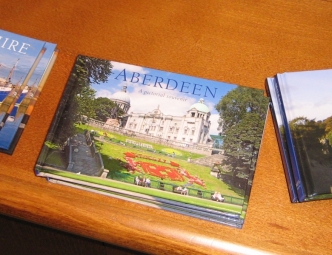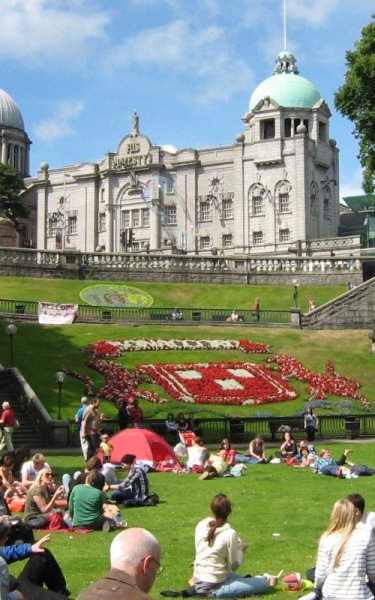Voice’s Suzanne Kelly provides further detail regarding The Scottish Information Commission’s decision on Aberdeen City Council’s handling of FOI requests regarding sales to and contracts won by Stewart Milne related companies.
This week the Supreme Court sided with Aberdeen City Council and rejected Stewart Milne’s appeal concerning profit-sharing on a land deal.
Milne bought land from Aberdeen City Council (property worth some £5 million was sold to him for c £375,000) with a clause stipulating Milne had to share any related profits with the seller, Aberdeen City Council.
After lengthy appeals, the Milne Group must pay £1.7 million pounds to Aberdeen City Council (legal costs are at present unknown).
Precisely how and why the cash-strapped City Council made this deal still remains unclear. Once acquired, the property was sold from one arm of the Milne group of companies to another, and on this basis, Milne’s position was that there were no profits to share. The Courts have disagreed.
This issue spurred a freedom of information request to the City Council.
What land had been sold to Milne-related companies? What contracts had been awarded to the Milne companies? Was a group of companies receiving preferential treatment by being sold public assets without the assets going on the open market to the highest bidder? Was a construction firm buying land at considerable discount with one hand, and at the same time under-bidding competition to win work?
It is a year (and a few days) since the initial FOI request was lodged with Aberdeen City Council. Late replies, denials that information was held, assertions that information was too difficult and costly to obtain were some of the obstacles in the way of obtaining information.
If not for the Information Commission, there would be no chance of this information – concerning public assets and the public purse – coming to light. As it is, the City has until 23 January to finally comply. At that time it must either disclose the information or lodge an appeal against the decision.
The decision will be disclosed to the public around 16th December. In the meantime, here are some of the important issues and facts to emerge from the Information Commissioner’s decision.
On 10 December 2010 a FOI request was sent to Aberdeen City. Such requests are to be answered within a specific time frame and are backed up by legislation.
The City failed to respond in time. Aberdeen’s representatives said the information was not easy to obtain, would cost over £600 pounds to collect, and that some of the data was immune from disclosure. When the request was largely turned down, an internal investigation by ACC into its handling of the affair was requested as the law permits. The City was sorry it was late in responding, but it was not going to release the information.
Findings:
The Information Commissioner’s office was supplied with the entire (lengthy) chain of emails from the first request through the refusal and the internal investigation. The Commissioner will soon release its report into ‘Case 243/2011’ and these points are among the findings:-
- ACC FAILED to comply with Part 1 of the Information (Scotland) Regulations 2002 (FOISA)
- ACC FAILED to comply with the Environmental Information (Scotland) Regulations 2004
- ACC FAILED in dealing with the request by wrongly claiming that section 12(1) of FOISA was applicable to the request
- ACC FAILED to provide reasonable advice and assistance under Section 15(1) of FOISA.
- ACC FAILED to meet statutory timescales for handling the request
Background:
The comprehensive decision from the Commission covers the history, legal issues and relevant points of my request. The Background section covers my initial questions to Aberdeen:
1. List of property (including but not limited to land, buildings, building services, material goods, etc.) Aberdeen City sold to the Stewart Milne Group, Stewart Milne Homes and/or any associated companies, and/or directly to Mr Stewart Milne. List to show property name/description, date of sale, sale price, minutes/reports of the City Council approving/recommending the sale, and if available the market value at time of sale.
2. List of property or services (including but not limited to land, buildings, building services, material goods, etc.), the Stewart Milne Group, Stewart Milne Homes and/or any associated companies, and/or directly to Mr Stewart Milne sold, managed or built for Aberdeen City Council. List to show property name/description, date of sale, price, reports/minutes of the City Council recommending the purchase, and if available the market value at time of sale.
If any aspect of this request is not clear, then please contact me directly for clarification.
I was asked to clarify what I meant by Stewart Milne associated companies, and on the same day as the request was emailed to me, I sent this list from Companies House:-
| 05232604 |
|
D
|
STEWART-MILNE CATERING LIMITED |
Dissolved |
| SC305012 |
|
|
STEWART MILNE CENTRAL LIMITED |
|
| SC152943 |
|
|
STEWART MILNE COMMERCIAL LIMITED |
|
| SC083265 |
|
|
STEWART MILNE CONSTRUCTION LIMITED |
|
| SC054259 |
|
|
STEWART MILNE DEVELOPMENTS LIMITED |
|
| SC191167 |
|
|
STEWART MILNE (GLASGOW) LIMITED |
|
| SC057709 |
|
|
STEWART MILNE GROUP LIMITED |
|
| SC132524 |
|
|
STEWART MILNE HOLDINGS LIMITED |
|
| SC137803 |
|
|
STEWART MILNE HOME OPTIONS LIMITED |
|
| SC065403 |
|
|
STEWART MILNE HOMES LIMITED |
|
| SC096898 |
|
|
STEWART MILNE HOMES (SOUTHERN) LIMITED |
|
| SC056620 |
|
|
STEWART MILNE INVESTMENTS LIMITED |
|
| SC063606 |
|
|
STEWART MILNE INVESTMENTS (SCOTLAND) LIMITED |
|
| SC349644 |
|
D
|
STEWART MILNE KITCHENS AND BATHROOMS LIMITED |
Dissolved |
| SC204848 |
|
|
STEWART MILNE PART EXCHANGE LIMITED |
|
| SC145941 |
|
|
STEWART MILNE PROPERTIES LIMITED |
|
| SC192726 |
|
|
STEWART MILNE (WEST) LIMITED |
|
| SC305009 |
|
|
STEWART MILNE WESTHILL LIMITED |
|
The City also wanted to know what time period the request covered. This was a bit of a surprise – was the list of property sold so extensive that a cut-off date was needed? Dates of 1980 to the present were chosen.
On 9 February 2011 the City advised that the request would be too costly, and that it did not hold information relating to property it had sold to Stewart Milne companies. An internal inquiry into how the City handled my request was offered and accepted. This inquiry proved rather fruitless, and on 4 May 2011 the Office of the Scottish Information Commissioner was asked to look into the case. The investigation began.
The Information Commissioner’s office contacted Aberdeen City Council on a number of points. One of the issues was whether or not all or part of the FOI questions should have been dealt with as an Environmental Request (EIR). The City then told the Commissioner’s office it ‘no longer wished to withhold the information in the reports (about tenders) in their entirety. Some but not all the information on contracts Stewart Milne companies had won in September was released. This included information about new build work at Byron Park, Hayton Road and Rorie Hall. The documents were heavily redacted.
It was nine months since the FOI questions were first asked of ACC. At one stage during the Commissioner’s investigation there was an opportunity to re-state the case and explain why the information should be put in the public domain. I wrote about the state of Aberdeen’s finances, the fairly recent criticism of the City’s fiscal operations by Audit Scotland, the lack of transparency in the City’s dealings, and my concern for the disposal of public assets without clear attempt to get the best possible market price.
The decision notes my claim that ‘public assets should be bought and sold in a fully transparent manner, especially in such a cash-strapped city as Aberdeen.’ I wondered if my efforts would be enough. I waited.
Findings & Analysis:
One of the most important reasons for refusing the request was cost. If the costs were truly going to exceed £600 (the threshold over which public authorities do not have to respond – but can if they wish to), then someone at ACC’s Freedom of Information Office should have offered guidance as to how to reduce the cost of the search. This never happened.
Aberdeen’s initial cost estimates indicated that many people would have had to spend hours on the request, and some of these hours were going to be charged at over £15 per hour. As it turned out, the maximum hourly rate that a public entity can charge for searches is £15 per hour. Perhaps someone in the City’s Information area should have known this?
Over the course of the dozens of e-mails exchanged, I made clear I did not accept Aberdeen’s claim that supplying a list of the property would be to arduous and too expensive.
At one point the City said some of its records were only on paper format. I informed the Information Commission that the City holds an Excel spread sheet detailing the property that it owns and that I considered it likely that the Council would have a similar spread sheet for property it disposed of.
Aberdeen said such a record did exist, but that it didn’t show to whom property had been sold. (This seems like a very poor state of record-keeping if it is the case). The City said its list would be ‘meaningless’ to me. The City estimated that it sells some 10 pieces of property per year, and we would be talking about 140 sales from 1996. In summary, the City said it would cost £1,117.50 (a rather precise figure I thought) to get the details I was after.
Item No. 50 of the Commissioner’s decision reads:
“…the Commissioner is surprised that the Council is unable to establish the identity of the purchaser in relation to individual property disposals in a less labour intensive manner, he accepts that the Council does not have simple access to the information requested…”
Here are some other points from the report concerning the issues:-
51. “Having considered the Council’s submissions, the Commissioner accepts that it has identified a reasonable method of locating and retrieving the information Ms Kelly has requested. This involves two distinct stages: firstly identifying those property sales in which the purchaser was one of the parties of interest to Ms Kelly and then secondly locating and providing, for only those transactions involving relevant purchasers, the particular pieces of information requested by Ms Kelly about that transaction. The Commissioner is satisfied that the information requested could all be located within the file relating to the property sale.”
52. “Turning to the Council’s estimates of the staff time required to complete this process, the investigating officer reviewed the copy of a file provided by the Council. Although this contained over 780 pages of information, the investigating officer was able to identify the purchaser of the land or property within two minutes of opening the electronic file. Although, in this case, the purchaser was not one of interest to Ms Kelly, the investigating officer went on to locate the types of information about the sale she had requested. The investigating officer was able to identify and extract the relevant information from this file within a further 15 minutes.”
53. “Having considered the Council’s (somewhat limited) submissions and the investigating officer’s review of the sample file, the Commissioner is unable to accept the Council’s estimate that it would take 30 hours to establish which files involved sales to relevant parties. This suggests that this initial stage would take an average of just under 13 minutes per file….”
The Commissioner’s findings on the issue of retrieving the information are even more concerning than just this over-calculation on the City’s part. Looking back to an earlier point, it seems the Council are no longer keeping records of crucial information such as how public assets are disposed of:-
43. “The Council explained that there is no longer a comprehensive database which records all transactions…”
After a less-than-glowing recent report from Audit Scotland into Aberdeen’s property management – why is there ‘no longer a comprehensive database’ concerning important transactions?
The decision then goes to the matter of the ‘duty to provide advice and assistance’. The Information Commissioner found
“…the Council offered no advice and assistance to Ms Kelly on how she might reduce the scope of her request…” and “Given that the Council provided no advice or assistance to Ms Kelly in either narrowing the scope of her request, or accessing some of the information of interest to her, the Commissioner finds that the Council failed to comply with its duty…”
Part of my FOI request concerned contracts won by Milne companies. Were we selling land at very favourable rates to a bidder who might put in low bids? Would it be possible that a contractor won work by bidding lower than the competition, but that another company connected to the contractor bought land at profit-making prices – possibly even to the detriment of the public purse? This possibility crossed my mind.
The Council felt harm would be done if details of contracts awarded were publicised. I commented that there was a need for confidentiality during negotiations of a contract, but not once a deal is concluded where public money is being spent.
The Commissioner noted that my requests were about one year after the contracts were awarded. The tenders had been evaluated; the contracts were issued. As it turned out, the unsuccessful bidders had been advised of the details after the award – but by some kind of oversight or another on the part of Aberdeen City Council, this information was never made available to the public despite EU law making such disclosure mandatory.
This is what the Commissioner’s investigation found:-
“The Commissioner is unable to accept that a competing company would be able to gain significant insights into the relevant company’s capabilities, pricing or bidding strategies from the disclosure of this information [information re. Bids]… the commercial sensitivity of that information will have diminished with the passage of time, and in particular with the award of the contracts in the subsequent phase in the Council’s home building programme. The Council has provided no evidence to support its submission regarding the continued risk or harm following from the disclosures of that information.”
More to come:
The decision has been released to me and the City. They have until 23 January 2012 to lodge an appeal or comply. The Commissioner’s intervention and in-depth analysis is greatly appreciated and clearly was much needed.
This report will be available to the public via the internet c. 16 December. It will prove a valuable read to other researchers and anyone interested in how Aberdeen City Council handles information and requests for information. However, one year on from asking the initial questions, there are still crucial questions unanswered:-
- Who suggested selling land to Milne companies? What was their position in ACC?
- Exactly what public assets have been sold to Milne related companies?
- Who in the City was involved in progressing and approving the sales?
- Were any bids won by placing bids with very low likely profit margins?
- What internal audit procedures, if any, flagged up any issues with the sales or contract awards?
- Does anyone within this chain of decision making have any links to any of the Milne-related companies?
Further information on this subject will be forthcoming. Aberdeen Voice will be reporting on the City’s next move.


